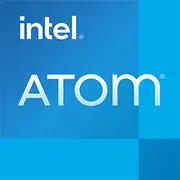Intel Atom Z2480

Intel Atom Z2480: Miniature Energy Efficiency for Niche Tasks
Introduction
In an era when the market is flooded with multi-core processors and neural network accelerators, the Intel Atom Z2480 seems like a relic of the past. However, even in 2025, this chip remains relevant in specific scenarios. Let’s explore who might benefit from this 32nm "little one" with a TDP of 3 watts.
Architecture and Technology Process: Penwell — An Era of Miniaturization
Codename Penwell: What’s Inside?
The Intel Atom Z2480, released in 2012, is built on a 32nm technology process. This single-core solution supports Hyper-Threading (2 threads), but in this particular model, it is disabled — the Z2480 operates strictly with 1 core and 1 thread. The base frequency is 1.6 GHz, with Turbo Boost capabilities up to 2.0 GHz.
Architecture Features:
- Saltwell (2nd generation Atom): A simplified architecture focused on low power consumption.
- Integrated Graphics GMA (Graphics Media Accelerator): A block running at 400 MHz, supporting basic video decoding (MPEG-2, H.264) and resolutions up to 720p.
- Cache: 512 KB L2, which is minimal even for its time.
Why 32nm?
The 32nm process allowed Intel to create compact chips for mobile devices. However, by 2015, it was replaced by 14nm technologies, making it appear archaic by 2025.
Energy Consumption and TDP: 3 Watts — A Record for Efficiency
TDP of 3 Watts:
A thermal design power of 3 watts is a key advantage of the Z2480. This allowed the processor to be used in:
- Ultra-thin tablets (e.g., Dell Latitude 10).
- Compact laptops with passive cooling (fanless).
- Industrial and embedded systems.
Energy Efficiency in Details:
- Core Voltage: 0.85–1.1 V.
- Power-saving modes: Enhanced SpeedStep (dynamic frequency scaling), C-states (disabling unused blocks).
Performance: What Can Z2480 Do in 2025?
Office Tasks:
- Browsing: Opening 3–5 tabs in Chrome (considering optimization for older OS) is possible but slow.
- Documents: Working with Word and Excel (2010–2013 versions) is comfortable, but modern packages (Microsoft 365) will lag.
Multimedia:
- Video: Playing 720p via VLC or MPC-HC (with hardware acceleration). 1080p experiences stuttering.
- Music/Photos: Listening to tracks and editing photos in Lightroom 3 represents the limits of its capabilities.
Gaming:
- 2010s Games: Minecraft (at lowest settings), Stardew Valley — 20–30 FPS.
- Modern Titles: Even 2D indie games like Hollow Knight require optimization.
Turbo Boost: An Illusion of Speed?
Turbo mode (up to 2.0 GHz) activates rarely — only under brief loads. In reality, the gain rarely exceeds 10–15%.
Use Cases: Who Needs Z2480 in 2025?
1. Devices for Basic Tasks:
- Data entry terminals (e.g., in logistics).
- Kiosks, information panels.
2. Retro Gadgets:
- Laptops with Windows XP/7 for enthusiasts (e.g., ASUS Eee PC).
3. Educational Projects:
- Children's laptops with limited functionality (price: $150–$200).
Caution: Modern OS (Windows 10/11, Linux with heavy DE) are not recommended.
Battery Life: 10+ Hours — Reality or Myth?
Impact of TDP on Battery:
In devices with a 20–30 Wh battery (e.g., Lenovo ThinkPad Tablet 2), the Z2480 provided 8–10 hours of operation. However, by 2025, battery degradation reduces this time to 4–6 hours.
Power-saving Technologies:
- Enhanced Intel SpeedStep: Reduces frequency to 800 MHz during idle.
- Display Power Saving Technology (DPST): Dynamic screen brightness adjustment.
Comparison with Competitors: Amidst ARM and AMD
AMD C-60 (2011):
- 2 cores, TDP 9 W, graphics Radeon HD 6290.
- Performance is 30% higher but worse battery life.
Apple A5 (2011):
- Used in iPad 2. Better optimization for iOS but a closed ecosystem.
Modern Counterparts (2025):
- Intel N100 (7 nm, 6 W): 4 cores, UHD graphics, 4K support. Device prices: $250–$300.
- Qualcomm Snapdragon 7c (ARM): Battery life 20+ hours, 5G integration.
Conclusion: The Z2480 lags behind even budget chips of 2025 but wins in secondary market pricing.
Pros and Cons: A Compromise Not for Everyone
Strengths:
- Ultra-low power consumption.
- Passive cooling (no noise).
- Compatibility with legacy software (e.g., industrial programs on Windows Embedded).
Weaknesses:
- Zero multitasking.
- Lack of support for modern standards (USB 3.0, Wi-Fi 6).
- GMA graphics struggling with HD video in the browser.
Device Selection Recommendations
Types of Devices:
- Ultra-budget Laptops: For example, Chuwi Minibook (price: $180).
- Specialized Gadgets: Terminals, POS systems.
What to Look For:
- RAM Size: Minimum 2 GB (preferably 4 GB for Windows 10 LTSC).
- Storage: SSD is mandatory (even 64 GB).
- Ports: HDMI, USB 2.0 — basic minimum.
Advice: Avoid devices with HDD — this is a performance bottleneck.
Final Conclusion: For a Very Narrow Audience
The Intel Atom Z2480 in 2025 remains a choice for:
- Retro technology enthusiasts.
- Businesses needing cheap terminals.
- Educational projects with minimal budgets.
Key Benefits:
- Extremely low price (devices from $150).
- Compatibility with legacy software.
- Silent operation.
Alternative: If budget allows $250–$300 — consider Intel N100 or ARM solutions.
Epilogue: Nostalgia or Pragmatism?
The Z2480 serves as a reminder of how far technology has come. Yet even today, in a world of AI and quantum computing, there is room for humble chips addressing their niche tasks.
Basic
CPU Specifications
Memory Specifications
GPU Specifications
Benchmarks
Compared to Other CPU
Share in social media
Or Link To Us
<a href="https://cputronic.com/en/cpu/intel-atom-z2480" target="_blank">Intel Atom Z2480</a>